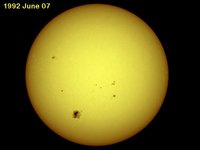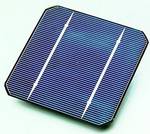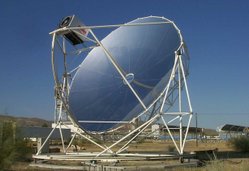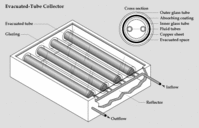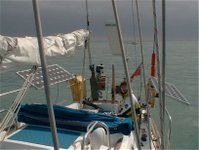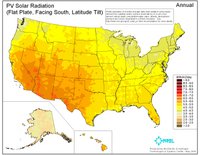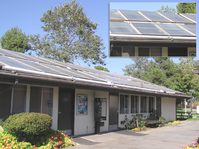|
SOLAR POWER
|
||||||||||||||
|
5 JUNE 2013
Germany’s Conergy, a vertically integrated PV manufacturer and developer, is now installing PV systems in Spain that are producing electricity at grid-competitive rates without subsidies. The company said it’s now hit the 1 megawatt mark of such projects.
Spain has joined a growing number of countries where solar is becoming as cheap as other electric sources on the grid without subsidies, among them
South Africa and Brazil.
www.renewableenergyworld.com/conergy-installing-solar-at-cost-of-conventional-electricity-in-spain
SOLAR POWER
Solar power describes a number of methods of harnessing energy from the light of the Sun. It has been present in many traditional building methods for centuries, but has become of increasing interest in developed countries as the environmental costs and limited supply of other power sources such as fossil fuels are realized. It is already in widespread use where other power supplies are absent, such as in remote locations and in space.
The Sun gives 1,400 watts/m² at distance of Earth's orbit, less at ground level
Energy from the Sun
The rate at which solar radiation reaches a unit of area in space in the region of the Earth's orbit is approximately 1,400 W/m², as measured upon a surface normal (at a right angle) to the Sun. This number is referred to as the solar constant. Of the energy received, roughly 19% is absorbed by the atmosphere, while clouds on average reflect a further 35% of the total energy. The generally accepted standard is for peak power of 1020 W/m² at sea level.
The average power, which is an important quantity when one is considering using solar power, is lower. For example, in North America the average power lies somewhere between 125 and 375 W/m², between 3 and 9 kWh/m²/day. It should be noted that maximum solar radiation energy intensity is meant here, and not the power delivered by a photovoltaic panel, which are about 15% efficient. Hence, a solar panel delivers 15 to 60 W/m² or 0.45-1.35 kWh/m²/day (annual day and night average).
After passing through the Earth's atmosphere, most of the sun's energy is in the form of visible and ultraviolet light. Plants use solar energy to create chemical energy through photosynthesis. Humans regularly use this energy burning wood or fossil fuels, or when simply eating the plants.
Classification
A wide range of power technologies exist which can make use of the solar energy reaching Earth. These can be classified in a number of different ways.
Method of energy transformation
Solar energy can be transformed for use elsewhere or utilised directly.
photovoltaic cell produces electricity directly from solar energy
Direct solar power involves only one transformation into a usable form. For example:
Indirect solar power involves more than one transformation to reach a usable form. Many other types of power generation are indirectly solar-powered. Some of these are so indirect that they are often excluded from discussion of solar power:
Hydroelectric power use indirect solar power - Itaipu Dam Brazil / Paraguay
Complexity of mechanism
Solar power can also be classified as passive or active:
Focus type
Effective use of solar radiation often requires the radiation (light) to be focused to give a higher intensity beam. Consequently, another scheme for classifying solar power systems is:
Types of technologies
Most solar energy used today is harnessed as heat or electricity.
Solar design in architecture
Solar design is the use of architectural features to replace the use of grid electricity and fossil fuels with the use of solar energy and decrease the energy needed in a home or building with insulation and efficient lighting and appliances. Architectural features used in solar design:
Point focus parabolic dish Stirling System Plataforma Solar de Almería (PSA) Spain
Solar heating systems
Solar heating systems are generally composed of solar thermal collectors, a fluid system to move the heat from the collector to its point of usage, and a reservoir to stock the heat for subsequent use. The systems may be used to heat domestic hot water or a swimming pool, or to provide heat for a heating circuit (usually radiators or floor heating coils). The heat can also be used for industrial applications or as an energy input for other uses such as cooling equipment.
In many climates, a solar heating system can provide a very high percentage (50 to 75%) of domestic hot water energy. In many northern European countries, combined hot water and space heating systems are used to provide 15 to 25% of home heating energy.
Residential solar thermal installations can be subdivided in two kind of systems: compact and pumped systems. Both typically include an auxiliary energy source (electric heating element or connection to a gas or fuel oil central heating system) that is activated when the water in the tank falls below a minimum temperature setting such as 50 °C. Hence, hot water is always available.
Compact systems
Also known as a monobloc system, a compact system consists of a tank for the heated water, a solar collector, and connecting pipes all pre-mounted in a frame. Based on the thermosiphon principle, the water flows upwards when heated in the panel. When this water enters the tank (positioned higher than the solar panel), it expels some cold water from inside so that the heat transfer takes place without the need for a pump. A typical system for a four-person home in a sunny region consists of a tank of 150 to 300 liters and three to four square meters of solar collector panels.
Direct compact systems are not suitable for cold climates. At night the remaining water can freeze and damage the panels, and the storage tank is exposed to the outdoor temperatures that will cause excessive heat losses on cold days. Some compact systems have a primary circuit. The primary circuit includes the collectors and the external part of the tank. Instead of water, a non-toxic antifreezing liquid is used. When this liquid is heated up, it flows to the external part of the tank and transfers the heat to the water placed inside. However, direct systems are slightly cheaper and more efficient.
A compact system can save up to 4.5 tonnes annually of gas emissions. In order to achieve the aims of the Kyoto Protocol, several countries are offering subsidies to the end user. Some systems can work for up to 25 years with minimum maintenance. These kinds of systems can be redeemed in six years, and achieve a positive balance of energy (energy used to build them minus energy they save) of 1.5 years. Most part of the year, when the electric heating element is not working, these systems do not use any external source for power (as water flows due to thermosyphon principle).
Flat solar thermal collectors are usually used, but compact systems using vacuum tube collectors are available on the market. These generally give a higher heat yield per square meter but also cost more than flat collector systems.
Pumped systems
Systems using a circulation pump are used whenever the hot water tank is positioned below the solar panels. Most systems in northern Europe are of this type. The storage tank is placed inside the building, and thus require a controller that measures when the water is hotter in the panels than in the tank. The system also requires a pump for transferring the fluid between the parts.
The electronic controllers used by these systems permit a wide range of functionality such as measurement of the energy produced; more sophisticated safety functions; thermostatic and time-clock control of auxiliary heat, hot water circulation loops, or others; display or transfer of error messages or alarms; remote display panels; and remote or local datalogging
The most commonly used solar collector is the insulated glazed flat panel. Less expensive panels, like polypropylene panels (for swimming pools) or higher-performing ones like vacuum tube collectors, are sometimes used.
Evacuated (or vacuum) tubes panel
Solar heating thermal collectors
There are three main kind of solar thermal collectors in common use. Formed Plastic Collectors (such as polypropelene, EPDM or PET plastics) consist of tubes or formed panels through which water is circulated and heated by the sun's radiation. Used for extending the swimming season in swimming pools. In some countries heating an open-air swimming pool with non-renewable energy sources is not allowed, and then these cheap systems offer a good solution. This panel is not suitable for year round uses like providing hot water for home use, primarily due to its lack of insulation which reduces its effectiveness greatly when the ambient air temperature is lower than than temperature of the fluid being heated.
A flat collector consists of a thin absorber sheet (usually copper, to which a selective coating is applied) backed by a grid or coil of fluid tubing and placed in an insulated casing with a glass cover. Fluid is circulated through the tubing to remove the heat from the absorber and transport it to an insulated water tank, to a heat exchanger, or to some other device for using the heated fluid.
Flat-plate collectors for solar water heating were popular in Florida and Southern California in the 1920s. There was a flicker of resurgence of interest in them in North America in the 1970s. However, the main action is now in other countries where considerable strides have been that enable effective use of solar heating in both private houses and large scale installations. Technical innovation has improved performance, life expectancy and ease of use of these systems, with Germany/Austria the clear leaders. Installation of solar hot water heating has become the norm in countries such as Isreal and Greece, where there is an abundance of solar radiation, and Japan and Austria where there is considerably less.
Evacuated tube collectors are made of a series of modular tubes, mounted in parallel, whose number can be added to or reduced as hot water delivery needs change. This type of collector consists of rows of parallel transparent glass tubes, each of which contains an absorber tube (in place of the absorber plate to which metal tubes are attached in a flat-plate collector). The tubes are covered with a special light-modulating coating. In an evacuated tube collector, sunlight passing through an outer glass tube heats the absorber tube contained within it.
Two types of tube collectors are distinguished by their heat tranfer method: the simplest pumps a heat transfer fluid (water or antifreeze) through a U-shaped copper tube placed in each of the glass collector tubes. The second type uses a sealed heat pipe that contains a liquid that vaporizes as it is heated. The vapor rises to a heat-transfer bulb that is positioned outside the collector tube in a pipe through which a second heat transfer liquid (the water or antifreeze) is pumped. For both types, the heated liquid then circulates through a heat exchanger and gives off its heat to water that is stored in a storage tank (which itself may be kept warm partially by sunlight). Evacuated tube collectors heat to higher temperatures, with some models providing considerably more solar yield per square meter than flat panels. However, they are more expensive and fragile than flat panels.
Solar thermal cooling
There are some new applications of thermal hot water, such as air cooling, currently under development. The absorber machine works like a refrigerator — it uses hot water to compress a gas that, once expanded, will produce an endothermic reaction, which cools the air. The main problem currently is that the absorber machine works with liquid at 90 °C, a fairly high temperature to be reached with pumped solar panels with no auxiliary power supply.
The same pumped solar thermal installation can be used for producing hot water for the whole year. It can also be used for cooling in the summer and partially heating the building in winter.
Solar panels on this yacht charge 12 V batteries up to 9 Amps in full sunlight
Photovoltaic cells
Solar cells, also referred to as photovoltaic cells, are devices or banks of devices that use the photovoltaic effect of semiconductors to generate electricity directly from sunlight. Until recently, their use has been limited due to high manufacturing costs. One cost effective use has been in very low-power devices such as calculators with LCDs. Another use has been in remote applications such as roadside emergency telephones, remote sensing, cathodic protection of pipe lines, and limited "off grid" home power applications. A third use has been in powering orbiting satellites and other spacecraft.
However, the continual decline of manufacturing costs (dropping at 3 to 5% a year in recent years) is expanding the range of cost-effective uses. The average lowest retail cost of a large solar panel declined from $7.50 to $4 per watt between 1990 and 2005. With many jurisdictions now giving tax and rebate incentives, solar electric power can now pay for itself in five to ten years in many places. "Grid-connected" systems - that is, systems with no battery that connect to the utility grid through a special inverter - now make up the largest part of the market. In 2004 the worldwide production of solar cells increased by 60%. 2005 is expected to see large growth again, but shortages of refined silicon have been hampering production worldwide since late 2004.
Photovoltaic/Concentrator Hybrid Systems
In order to save on solar cell cost by maximizing the utilization of expensive high-efficiency (37%) cells, one solution is to use a lens such as a Fresnel lens or mirrors to concentrate the solar rays onto a small area. Such systems may deliver energy for less than $3/watt and power density as high as 450 (kW·h/m²)/year. The disadvantage, just like for any concentrator based system, is that such a setup needs moving parts—i.e., a tracking system—to follow the Sun around, and it's unable to efficiently harness diffuse light, such as during bright but cloudy days. However, solar power only makes economic sense in places where there are ample bright sunny days, and these concentrator/photovoltaic hybrid systems may ultimately win the final price/delivered watt battle of any solar design and prevail in the marketplace. Solar thermal electric power plants
The two main types of solar thermal power plants are Solar Chimneys and Concentrating Solar Power (CSP) plants. Concentrated Solar Power (CSP) Plants
Solar Two, a concentrating solar power plant
Solar chimney
A solar chimney is a relatively low tech solar thermal power plant where air passes under a very large agricultural glass house (between 2 and 30 km in diameter), is heated by the sun and channeled upwards towards a convection tower. It then rises naturally and is used to drive turbines, which generate electricity. Energy Tower
An Energy tower is an alternative proposal for the solar chimney. The "Energy Tower" is driven by spraying water at the top of the tower; evaporation of water causes a downdraft by cooling the air thereby increasing its density, driving windturbines at the bottom of the tower. It requires a hot arid climate and large quantities of water, but it does not require a large glass house
Solar pond
Another low-tech approach to harvesting solar energy is the solar pond. The basic idea is to fill the pond with 3 layers of water: The top layer has a low salt content, while the bottom layer has a high salt content. There is an intermediate insulating layer with a salt gradient, which causes a density gradient that forbids heat exchange by natural convection. Heat is trapped in the salty bottom layer, and can be used for different purposes, such as heating of buildings or generating electricity. This approach may be particularly attractive for rural areas in developing countries.
Though very huge area collectors can be set up at very low cost - basically the cost of the clay-plastic liner - the setup is relatively difficult to maintain - the salt gradient is very delicate and is easily upset by wind, the pond can foul up with algea, the liner can spring a leak, the evaporated surface water needs to be constantly replenished, while the accumulating salt crystals could be both a valuable byproduct and a curse. Also, the energy obtained is in the form of low grade heat of 70-80°C compared to 20°C ambient temperature, which has an upper Carnot-cycle extractable efficiency of 1-(273.15+20)/(273.15+80)=15%, while a solar concentrator system with molten salt delivering high grade heat at 800°C would be able to convert 73% of absorbed solar heat int useful work, and be forced to divest only 27% as waste heat to the cold temperature reservoir (ambient air.)
Solar chemical
Solar chemical refers to a number of possible processes that harness solar energy by absorbing sunlight in a chemical reaction in a way similar to photosynthesis in plants but without using living organisms. No practical process has yet emerged. A promising approach is to use focussed sunlight to provide the energy needed to split water into its constituent hydrogen and oxygen in the presence of a metallic catalyst such as zinc. It is also possible to use solar energy to drive industrial chemical processes without a requirement for fossil fuel.
Phytochemical Energy Storage (Biofuels)
See Biofuels and Biodiesel The oil in plant seeds, in chemical terms, very closely resembles that of petroleum. Many, since the invention of the Diesel engine, have been using this form of captured solar energy as a fuel comparable to petrodiesel - for functional use in any diesel engine or generator and known as Biodiesel. A 1998 joint study by the U.S. Department of Energy (DOE) and the U.S. Department of Agriculture (USDA) traced many of the various costs involved in the production of biodiesel and found that overall, it yields 3.2 units of fuel product energy for every unit of fossil fuel energy consumed. Other Biofuels incluid ethanol, wood for stoves, ovens and furnaces, and methane gas produced from biofuels through chemical processes.
Solar cooking
A solar box cooker traps the Sun's power in an insulated box; these have been successfully used for cooking, pasteurization and fruit canning. Solar cooking is helping many developing countries, both reducing the demands for local firewood and maintaining a cleaner environment for the cooks. The first known western solar oven is attributed to Horace de Saussure.
Solar lighting
The interior of a building can be lit during daylight hours using fibre optic light pipes connected to a parabolic collector mounted on the roof. The manufacturer claims this gives a more natural interior light and can be used to reduce the energy demands of electric lighting.
US annual average solar energy received by a latitude tilt photovoltaic cell
Energy storage
For a stand-alone system, some means must be employed to store the collected energy for use during hours of darkness or cloud cover. The following list includes both mature and immature techniques:
Storage always has an extra stage of energy conversion, with consequent energy losses, greatly increasing capital costs. One way around this is to export excess power to the power grid, drawing it back when needed. This appears to use the power grid as a battery but in fact is relying on conventional energy production through the grid during the night.
Deployment of solar power
Deployment of solar power depends largely upon local conditions and requirements. But as all industrialised nations share a need for electricity, it is clear that solar power will increasingly be used to supply a cheap, reliable electricity supply.
Several experimental photovoltaic (PV) power plants of 300 to 600 kW capacity are connected to electricity grids in Europe and the U.S. Other major research is investigating economic ways to store the energy which is collected from the sun's rays during the day.
Africa
Africa is home to the over 9 million km² Sahara desert, whose overall capacity — assuming 50 MW/km² day/night/cloud average with 15% efficient photovoltaic panels — is over 450 TW, or over 4 million terawatt-hours per year. The current global energy consumption by humans, including all oil, natural gas, coal, nuclear, and hydroelectric, is pegged at about 13 TW.
Asia and Australia
Australia has one solar power station, at White Cliffs.
As of 2004, Japan had 1200 MWe installed. Japan currently consumes about half of worldwide production of solar modules, mostly for grid connected residential applications.
In terms of overall installed PV capacity, India comes fourth after Japan, Germany, and the United States (Indian Ministry of Non-conventional Energy Sources 2002). Government support and subsidies have been major influences in its progress. India's very long-term solar potential may be unparalleled in the world because it is one of the few places with an ideal combination of both high solar power reception and a large consumer base in the same place. India's theoretical solar potential is about 5000 TW·h per year (i.e. 600 GW), far more than its current total consumption.
In 2005, the Israeli government announced an international contract for building a 100 MW solar power plant to supply the electricity needs of more than 200,000 Israelis living in southern Israel. The plan may eventually allow the creation of a gigantic 500 MW power plant, making Israel a leader in solar power production.[13]
EuropeA large solar PV plant is planned for the island of Crete. Research continues into ways to make the actual solar collecting cells less expensive and more efficient.
A large parabolic reflector solar furnace is located in the Pyrenees at Odeillo, France. It is used for various research purposes.[14] Another site is the Loser in Austria.
The Plataforma Solar de Almería (PSA) in Spain, part of the Center for Energy, Environment and Technological Research (CIEMAT), is the largest center for research, development, and testing of concentrating solar technologies in Europe.[15]
In the United Kingdom, the tallest building in Manchester, the CIS Tower, was clad in photovoltaic panels at a cost of £5.5 million and started feeding electricity to the national grid on November 2005.[16]
California laundromat heats water via roof mounted solar panels
North America
In some areas of the United States, solar electric systems are already competitive with utility systems. As of 2005, there is a list of technical conditions that factor into the economic feasibility of going solar: the amount of sunlight that the area receives; the purchase cost of the system; the ability of the system owner to sell power back to the electric grid; and most importantly, the competing power prices from the local utility. For example, a photovoltaic system installed in Boston, Massachusetts, produces 25% less electricity than it would in Albuquerque, New Mexico, but yields roughly the same savings on utility bills since electricity costs more in Boston.
In addition to these considerations, many states and regions offer substantial incentives to improve the economics for potential consumers. Congress recently adopted the first federal tax breaks for residential solar since 1985 -- temporary credits available for systems installed in 2006 or 2007. Homeowners can claim one federal credit of up to $2,000 to cover 30% of a photovoltaic system's cost and another 30% credit of up to $2,000 for a solar thermal system. Fifteen states also offer tax breaks for solar, and two dozen states offer direct consumer rebates.
Solar One is a pilot solar-thermal project in the Mojave Desert near Barstow, California.
On August 11, 2005, Southern California Edison announced an agreement to purchase solar powered Stirling engines from Stirling Energy Systems over a twenty year period and in quantities (20,000 units) sufficient to generate 500 megawatts of electricity. These systems — to be installed on a 4,500 acre (18 km²) solar farm — will use mirrors to direct and concentrate sunlight onto the engines which will drive generators. Less than a month later, Stirling Energy Systems announced another agreement with San Diego Gas & Electric to provide between 300 and 900 megawatts of electricity.
The world's largest solar power plant is located in the Mojave Desert. Solel, an Israeli company, operates the plant, which consists of 1000 acres (4 km²) of solar reflectors. This plant produces 90% of the world's commercially produced solar power.
On Jan. 12, 2006, the California Public Utilities Commission approved the California Solar Initiative (CSI), a comprehensive $2.8 billion program that provides incentives toward solar development over 11 years. Concentrated Solar Power (CSP) Commercial Developments
A company called Stirling Energy Systems (SES) of Phoenix, Arizona is developing a CSP system called The Dish Stirling System that concentrates sunlight on a Stirling Engine to produce electricity. SES recently signed agreements with Southern California Edison and San Diego Gas & Electric to develop large solar arrays in the southern California deserts that utlize their Dish Stirling System to generate large amounts of solar electricity. The initial contracts call for 800 MegaWatts (MW) of electricity to be produced from Dish Stirling Systems arranged in two large series arrays, with the potential to expand the two arrays to 2,000 MW in the future (an electricity generation scale that is comparable to four coal-fired power plants). Each dish can produce up to 25 kilowatts (a fraction 1/40th of a MW) of electicity; therefore, to achieve their 800 MW goal SES will have to install over 32,000 SES dishes. One advantage of the SES approach is that the dishes operate in a series, and therefore if one dish must be taken out of service for repairs or replacement it will not affect the overall solar dish array operation.
More Information: Huge Solar Plants Bloom in Desert - Wired News 2005-11-15
See also:
References
LINKS:
The Solar Energy Industries Association is the national trade association for the US solar energy industry and has information on current commercial technologies and market developments. U.S. Department of Energy: Energy Efficiency and Renewable Energy Solar History Timeline National Renewable Energy Laboratory: Concentrating Solar Power (CSP) The International Energy Agency runs many large multinational solar power projects under the SolarPACES umbrella. ESTIF - European Solar Thermal Industry organization (statistics, market situation)
Library of public domain images of operational Solar Power projects from the World-wide Information System for Renewable Energy (WIRE). Learn More about Domestic Solar Panels and Solar Panel Installations PowerPedia Solar Energy Directory Focuses on futuristic solar energy delivery systems Solar Panel Information provides general information about the practical and ethical applications of solar technology. Residential Solar Power Systems - Photo Gallery Solar Energy Projects and Daily News. Futurecrisis.com Solar Garden Lights Applications of solar energy for households. Solar power home system installation process - Installation process in Northern California Huge Solar Plants Bloom in Desert - Solar-energy project in California. Wired.com Solar Facts - Information about all aspects of solar Solar Thermal Water Splitting PDFs from U.S. National Renewable Energy Laboratory (696k & 428k)
Use of solar cells in Kenya and Uganda, in Africa Pennicott, Katie, "Solar cell edges towards endless energy". 7 December 2001. PhysicsWeb. Dye Sensitized Solar Cells (DYSC) based on Nanocrystalline Oxide Semiconductor Films News searching: Solar Cell, Photovoltaic Historical: Photovoltaic Solar Energy Conversion: An Update Wladek Walukiewicz, Materials Sciences Division, Berkeley Lab.: Full Solar Spectrum Photovoltaic Materials Identified. Quote: "... Maximum, theoretically predicted efficiencies increase to 50%, 56%, and 72% for stacks of 2, 3, and 36 junctions with appropriately optimized energy gaps, respectively...." CNET: 5/12/03 SunPower Announces World's Most Efficient, Low-Cost Silicon Solar Cell Quote: "...The National Renewable Energy Laboratory (NREL) has verified 20.4 percent conversion efficiency for the A-300...." SunPower A-300 (pdf), SunPower 29 March 2002, Scientists Create New Solar Cell Quote: "...semiconducting plastic material known as P3HT... 1.7 percent for sunlight..." 15 February 03, 'Denim' solar panels to clothe future buildings Quote: "... Unlike conventional solar cells, the new, cheap material has no rigid silicon base..." Residential Solar Power Systems - Photo Gallery Examples of Photovoltaic Systems azonano.com: Carbon Nanotube Structures Could Provide More Efficient Solar Power for Soldiers 28 February 2005
Solarnavigator is designed to carry the Scorpion anti pirate weapon. A fleet of such autonomous vessels could be the basis of an international peacekeeping, and/or emergency rescue force, the same platform is also ideal for endurance high-speed low cost oceanographic surveys. This intelligent navigation system is collision regulation compliant, the first such system in the world to be so. It is planned to make the system available as a retro-fit kit for cargo ships, so they may benefit from improved course keeping and attendant fuel savings. At this time a human Captain and several crew are necessary on oil tankers. Automation such as with the SNAV system holds the prospect of reduced crewing levels and so operating costs for ocean transport.
|
||||||||||||||
|
This website is copyright © 1991- 2013 Electrick Publications. All rights reserved. The bird logo and names Solar Navigator and Blueplanet Ecostar are trademarks ™. The Blueplanet vehicle configuration is registered ®. All other trademarks hereby acknowledged and please note that this project should not be confused with the Australian: 'World Solar Challenge'™which is a superb road vehicle endurance race from Darwin to Adelaide. Max Energy Limited is an educational charity working hard to promote world peace.
|
||||||||||||||
